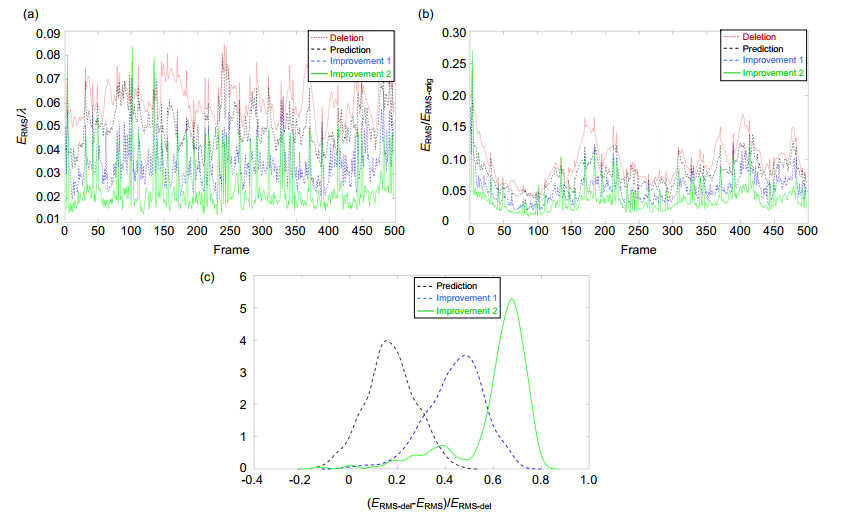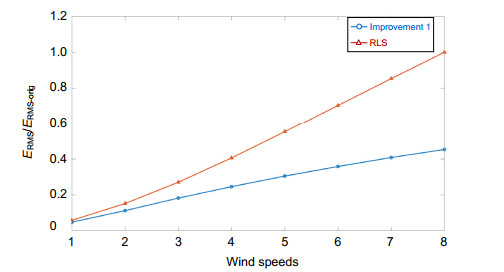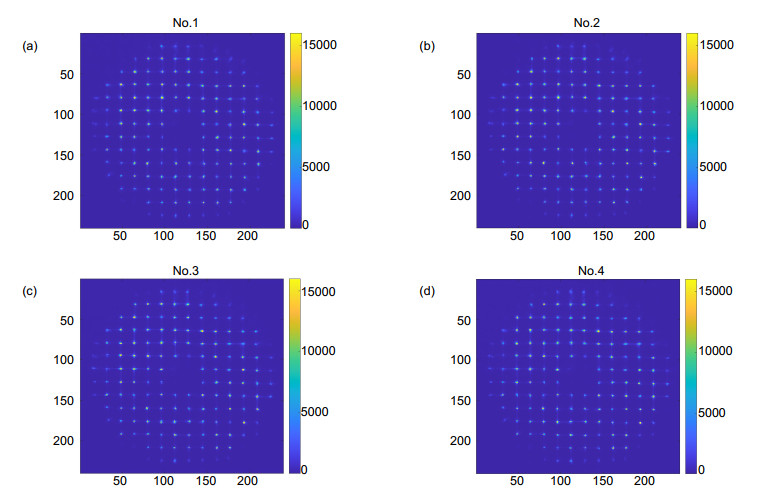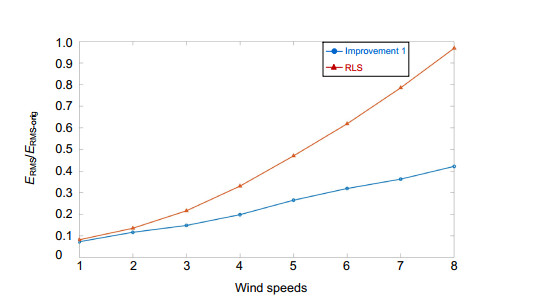-
摘要:
实际自适应光学控制系统中存在的时间延迟,导致校正器生成的校正面形与实际的波前畸变不匹配,产生校正滞后误差。基于大气冻结湍流假设,提出了一种基于运动估计的波前畸变预测方法,来补偿时间延迟带来的影响。方法具体采用模板匹配算法,根据参考帧和当前帧的波前复原图像进行大气湍流运动方向估计,然后对当前帧进行移动处理来实现对下一帧图像的预测。通过采用不同采样频率、不同横向风速度的仿真数据对比,评估预测方法的适用范围,讨论回溯帧数对预测效果的影响。也与采用最小递归二乘(RLS)模式预测方法的预测效果进行比较。仿真结果显示,在波前复原图像变化趋势较为明显的情况下,即横向风对大气湍流变化影响占主导地位时,方法表现更好,使得在天气较为恶劣的情况下仍能保持更佳的预测效果。最后使用实际天狼星观测数据对预测方法进行验证,整体仍保持预测效果。
 Abstract:
Abstract:In the actual adaptive optics control system, the time delay causes the mismatch between the correction profile generated by the corrector and the actual wavefront distortion, which leads to correction lag error. Under the atmospheric frozen flow turbulence assumption, a wavefront distortion prediction method based on motion estimation is proposed to compensate for the time delay. The template matching algorithm is used to estimate the atmospheric turbulence motion direction, according to the wavefront restored images of the reference frame and the current frame, and then the current frame is moved to predict the next frame. The prediction method applicability is evaluated, and the influence of backtracking frames on the prediction effect is discussed by comparing the simulation data of different sampling frequencies and different transverse wind speeds. The residual error is calculated with the template matching algorithm and the least recursive squares (RLS) algorithm. The simulation results show that the method performs better when the variation tendency of wavefront restored images is obvious. Therefore, the prediction effect can be maintained better in severe conditions. Finally, the prediction method is verified by using the actual observation data of Sirius, and the algorithm still keeps the prediction effect.
-
Key words:
- adaptive optics /
- turbulence prediction /
- motion estimation /
- wavefront correction
-

Overview: In the actual adaptive optics control system, the time delay causes the mismatch between the correction profile generated by the corrector and the actual wavefront distortion, which leads to correction lag error. The longer the time delay, the worse the overall system control performance. Under the atmospheric frozen flow turbulence assumption, the atmospheric turbulence spatial characteristics will not change significantly in a certain time scale, and the atmospheric frozen flow turbulence is driven by the atmospheric transverse wind. According to the turbulence temporal aberration characteristics, a wavefront distortion prediction method based on motion estimation is proposed. Through the wavefront restored images of the reference frame and the current frame, the template matching algorithm can estimate the atmospheric turbulence motion direction, and then the current frame is moved to predict the next frame. Under the simulation conditions of the sampling frequency of 500 Hz, the wavelength of 550 nm, the telescope aperture of 1.8 m, and the phase screen numbers of 10, the overall ideal correction error of the 65 orders Zernike wavefront image can be reduced from 0.0614λ to 0.0508λ by predictive compensation, and the relative correction residual is 7.62%. Furthermore, the residual error is calculated with the template matching algorithm and the least recursive squares (RLS) algorithm to evaluate the prediction effect. By comparing different sampling frequencies and different transverse wind speeds, the method performs better when the variation tendency of wavefront restored images is obvious. Therefore, the prediction effect can be maintained better in severe conditions. Since the actual wavefront distortion deviates from the frozen flow turbulence assumption, two improved methods are proposed. The first one calculates the ideal prediction correction residuals, and the second one directly predicts the ideal correction residuals, which can further reduce the overall ideal correction error to 0.0343λ and 0.0242λ. Correspondingly, the prediction method is verified by using the actual observation data of Sirius, Hartmann sensor microlens array numbers of 156, the sub-aperture resolution of 16×16, the sampling frequency of 500 Hz, and backtracking frame numbers of 3. The overall ideal correction error promotion effects of the 65 orders Zernike wavefront image are 15.97% and 24.85% using two improved methods. Increasing the recovery area can slightly improve the prediction effect, but it is not proportional to the calculation cost. The experimental results fit the theoretical analysis well, which suggests that the algorithm has certain practical value and is helpful in actual adaptive optics control systems.
-

-
表 1 仿真各相位屏参数设置
Table 1. Each phase screen parameter seting of simulation
1 2 3 4 5 h/km 4.4862 7.1606 9.8377 12.5174 15.1998 Cn2(e-17) 1.490316 1.217088 1.667488 1.249217 0.593580 R0 0.397161 0.483891 0.411039 0.482711 0.741458 Velocity 15.519397 29.131991 34.751609 24.676085 11.967457 Degree/(°) 200 220 240 260 280 6 7 8 9 10 h/km 17.8848 20.5724 23.2627 25.9557 28.6512 Cn2(e-17) 0.205803 0.056766 0.013164 0.002664 0.000483 R0 1.377634 2.942523 6.988659 18.042940 49.828203 Velocity 6.318604 5.133124 5.007156 5.000204 5.000003 Degree/(°) 270 260 250 240 230 表 2 不同风速下算法预测效果对比
Table 2. Comparison of the algorithm prediction effects under different wind speeds
1 2 3 4 5 6 7 8 ERMS-orig/λ 0.7181 0.7208 0.7233 0.7257 0.7280 0.7302 0.7322 0.7341 ERMS-del/λ 0.0614 0.1185 0.1707 0.2172 0.2585 0.2951 0.3278 0.3573 ERMS-pre/λ 0.0343 0.0806 0.1315 0.1781 0.2216 0.2612 0.2986 0.3322 η1 0.0478 0.1118 0.1818 0.2454 0.3044 0.3577 0.4078 0.4525 η2 0.4414 0.3198 0.2296 0.1800 0.1427 0.1149 0.0891 0.0702 Acc 0.9980 0.9960 0.9796 0.9672 0.9443 0.9129 0.8956 0.8529 表 3 自然星观测条件
Table 3. Conditions of Sirius observations
Data1 Data2 Temperature/℃ 8.50 8.50 Velocity/(m/s) 3.30-3.80 2.90-3.20 Degree/(°) 306-314 311-303 Visibility/km 50.78-50.95 50.77-50.78 Elevation 33°08′30.2″ 32°59′04.4″ 表 4 不同复原条件下算法预测效果对比
Table 4. Comparison of the algorithm prediction effects under different recovery conditions
ERMS-orig/λ ERMS-del/λ ERMS-pre/λ η1 η2 Acc Data1 (200×200) 4.5776 0.8594 0.6778 0.1481 0.2113 0.8029 Data2 (200×200) 6.0947 0.6618 0.5236 0.0859 0.2088 0.7386 Data1 (465×465) 4.5945 0.8626 0.6757 0.1471 0.2167 0.8183 -
[1] Gavel D T. Adaptive optics control strategies for extremely large telescopes[J]. Proc SPIE, 2002, 4494: 215–220. doi: 10.1117/12.454794
[2] 姜文汉. 自适应光学发展综述[J]. 光电工程, 2018, 45(3): 170489. doi: 10.12086/oee.2018.170489
Jiang W H. Overview of adaptive optics development[J]. Opto-Elec Eng, 2018, 45(3): 170489. doi: 10.12086/oee.2018.170489
[3] Andersen D R, Fischer M, Conan R, et al. VOLT: the victoria open loop testbed[J]. Proc SPIE, 2008, 7015: 70150H. http://www.onacademic.com/detail/journal_1000038704447910_f2e8.html
[4] 李新阳, 姜文汉. 自适应光学控制系统的有效带宽分析[J]. 光学学报, 1997, 17(12): 1697–1702. doi: 10.3321/j.issn:0253-2239.1997.12.020
Li X Y, Jiang W H. Effective bandwidth analysis of adaptive optics control system[J]. Acta Opt Sin, 1997, 17(12): 1697–1702. doi: 10.3321/j.issn:0253-2239.1997.12.020
[5] 李新阳, 姜文汉. 自适应光学系统的控制残余方差分析[J]. 光学学报, 2000, 20(10): 1328–1334. doi: 10.3321/j.issn:0253-2239.2000.10.006
Li X Y, Jiang W H. Analysis of the residual servo variance for an adaptive optics system[J]. Acta Opt Sin, 2000, 20(10): 1328–1334. doi: 10.3321/j.issn:0253-2239.2000.10.006
[6] 颜召军, 李新阳, 饶长辉. 一种自适应光学闭环系统预测控制算法的仿真研究[J]. 光学学报, 2011, 31(1): 0101003. https://www.cnki.com.cn/Article/CJFDTOTAL-GXXB201101004.htm
Yan Z J, Li X Y, Rao C H. Numerical simulation of a prediction control algorithm for close-loop adaptive optical system[J]. Acta Opt Sin, 2011, 31(1): 0101003. https://www.cnki.com.cn/Article/CJFDTOTAL-GXXB201101004.htm
[7] 刘超, 胡立发, 穆全全, 等. 用于开环液晶自适应光学系统的模式预测技术研究[J]. 物理学报, 2012, 61(12): 129501. doi: 10.7498/aps.61.129501
Liu C, Hu L F, Mu Q Q, et al. Modal prediction for open-loop liquid-crysta adaptive optics systems[J]. Acta Phys Sin, 2012, 61(12): 129501. doi: 10.7498/aps.61.129501
[8] Kulcsár C, Raynaud H F, Petit C, et al. Minimum variance prediction and control for adaptive optics[J]. Automatica, 2012, 48(9): 1939–1954. doi: 10.1016/j.automatica.2012.03.030
[9] Poyneer L, Véran J P. Predictive wavefront control for adaptive optics with arbitrary control loop delays[J]. J Opt Soc Am A Opt Image Sci Vis, 2008, 25(7): 1486–1496. doi: 10.1364/JOSAA.25.001486
[10] Paine S W, Fienup J R. Machine learning for improved image-based wavefront sensing[J]. Opt Lett, 2018, 43(6): 1235–1238. doi: 10.1364/OL.43.001235
[11] Guo H Y, Xu Y J, Li Q, et al. Improved Machine Learning Approach for Wavefront Sensing[J]. Sensors, 2019, 19(16): 3533. doi: 10.3390/s19163533
[12] Taylor G I. The spectrum of turbulence[J]. Proc Roy Soc A, 1938, 164(919): 476–490.
[13] Johnson L C, Gavel D T, Wiberg D M. Bulk wind estimation and prediction for adaptive optics control systems[J]. J Opt Soc Am A Opt Image Sci Vis, 2011, 28(8): 1566–1577. doi: 10.1364/JOSAA.28.001566
[14] 李正汉. 基于运动估计的自适应光学系统预测校正与图像配准技术研究[D]. 成都: 中国科学院大学(中国科学院光电技术研究所), 2020.
Li Z H. Predictive compensation and image registration in adaptive optics systems based on motion estimation[D]. Chengdu: University of Chinese Academy of Sciences (Institute of Optics and Electronics, Chinese Academy of Sciences), 2020.
[15] Kolmogorov A N. The local structure of turbulence in incompressible viscous fluid for very large Reynolds numbers[J]. Proc Roy Soc A, 1991, 434(1890): 9–13. doi: 10.1098/rspa.1991.0075
[16] He G W, Jin G D, Yang Y. Space-time correlations and dynamic coupling in turbulent flows[J]. Annu Rev Fluid Mech, 2017, 49(1): 51–70. doi: 10.1146/annurev-fluid-010816-060309
[17] Schock M, Spillar E J. Method for a quantitative investigation of the frozen flow hypothesis[J]. J Opt Soc Am A Opt Image Sci Vis, 2000, 17(9): 1650–1658. doi: 10.1364/JOSAA.17.001650
[18] Zhu C, Lin X, Chau L P. Hexagon-based search pattern for fast block motion estimation[J]. IEEE Trans Circuits Syst Video Technol, 2002, 12(5): 349–355. doi: 10.1109/TCSVT.2002.1003474
[19] Biswas B, Mukherjee R, Chakrabarti I, et al. A high-speed VLSI architecture for motion estimation using modified adaptive rood pattern search algorithm[J]. Circuits Syst Signal Process, 2018, 37(10): 4548–4567. doi: 10.1007/s00034-018-0778-8
-


 E-mail Alert
E-mail Alert RSS
RSS
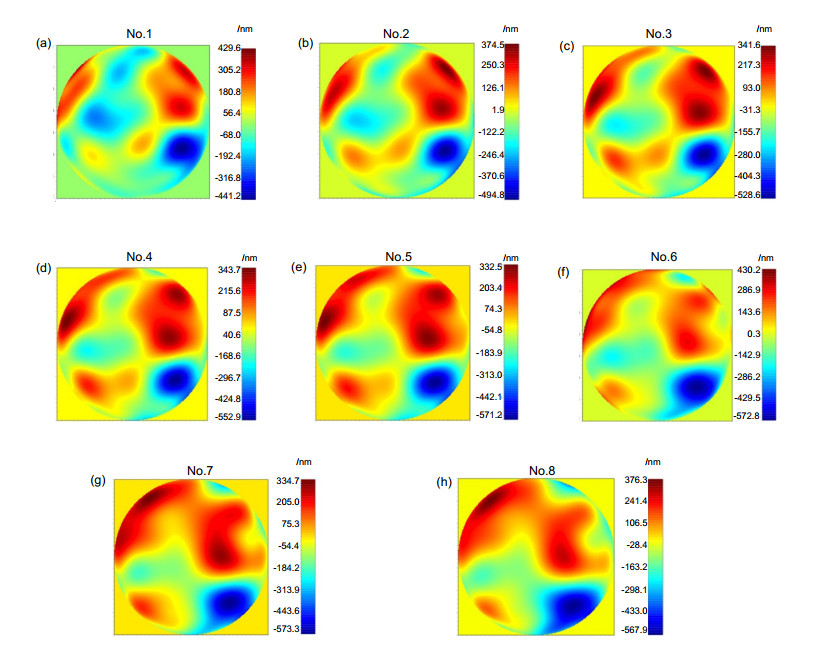
 下载:
下载:
